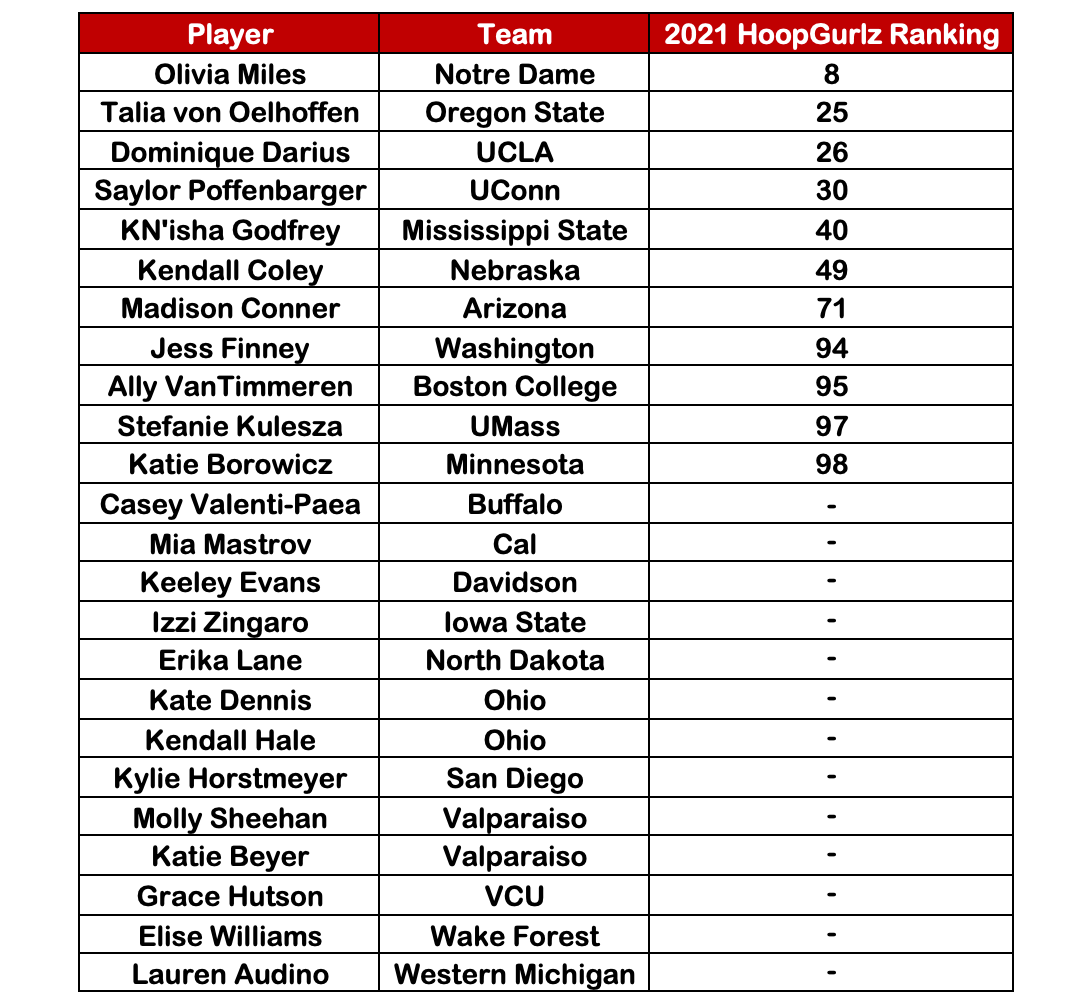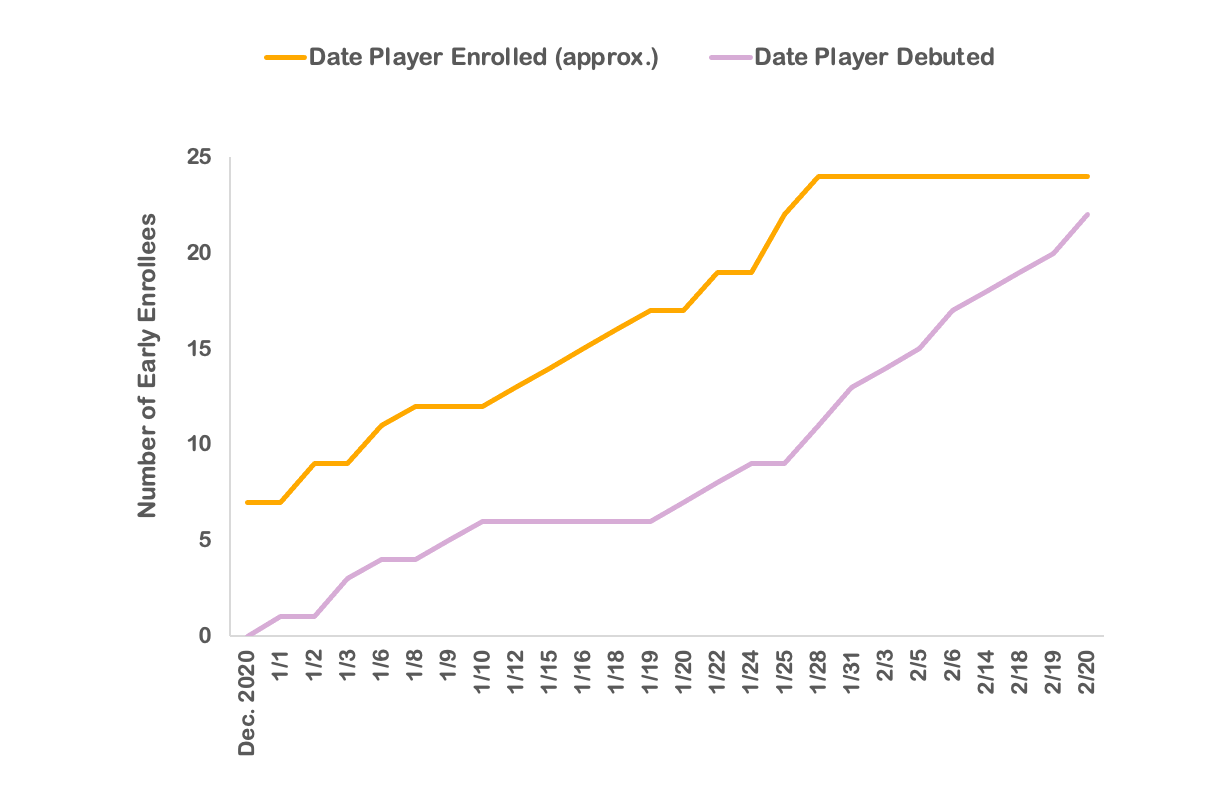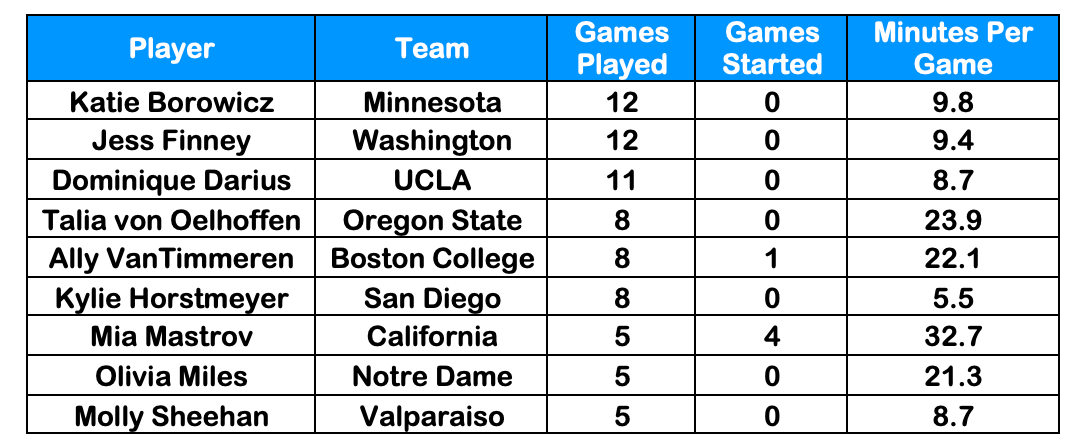Which Early Enrollees Have Made the Biggest Impacts This Season?
Twenty-four would-be high school seniors have enrolled in college early—and some could be factors in March
Thanks for reading the Her Hoop Stats Newsletter. If you like our work, be sure to check out our stats site, our podcast, and our social media accounts on Twitter, Facebook, and Instagram. You can also buy Her Hoop Stats gear, such as laptop stickers, mugs, and shirts!
Haven’t subscribed to the Her Hoop Stats Newsletter yet?
The 2020-21 women’s college basketball season has been unique in many ways, from the sheer number of COVID-19-related cancellations and opt-outs to the plan to host the entire NCAA Tournament in the state of Texas. One novel aspect that has received less attention is the large number of high school seniors who elected to enroll in college a semester early and play the second half of this season.
There are two main reasons why some players decided to make the leap early. First, the NCAA said in October that this season will not count toward players’ eligibility, making this a “bonus” semester of college for these freshmen. They will still be freshmen next season, but with a semester of college basketball and perhaps even a postseason run under their belts.
Second, several states have postponed high school sports, often with little indication of when they might resume. As of January 8—a point in time when many early enrollees were making their decisions or had just arrived on college campuses—20 states were not yet playing high school basketball. Illinois, Massachusetts, Michigan, New York, Rhode Island, and Vermont had not even announced a start date, and Hawaii had canceled the basketball season entirely.
In this context, players in some states no longer had to sacrifice their senior season of high school in order to start college early because there was no senior season to be had. And for both the players and their college coaches, anything the early enrollees learn or produce on the court this season is a plus, with four seasons of eligibility remaining.
“If school is over for you and the [high school] season has been canceled … why not take advantage of it?” UConn head coach Geno Auriemma said in January, shortly after his early enrollee, Saylor Poffenbarger, arrived on campus. “… Maybe she gets in a game, maybe she doesn’t. Maybe she contributes, maybe she doesn’t. … all that remains to be seen, but being out on the court and practicing, I think those are things that are beneficial.”
Let’s take a look at how many players have enrolled in college early this season and what their collective and individual impacts have been so far. Unless otherwise stated, all data are from Her Hoop Stats and include games through February 28, 2021.
How many players enrolled early, and where did they enroll?
To the best of our knowledge, 24 players at 22 different schools have enrolled early. Only Ohio (Kate Dennis and Kendall Hale) and Valparaiso (Katie Beyer and Molly Sheehan) have multiple early enrollees. Our full list of early enrollees is available at the end of this article.
The early enrollees represent 11 different conferences; the Pac-12 has the most with five, followed by the Mid-American Conference with four.
Eleven early enrollees are top-100 recruits in the 2021 class, according to espnW HoopGurlz. Notre Dame’s Olivia Miles is the highest-ranked player at No. 8, and five others rank in the top 50.
When did they arrive on campus, and how many have played in a game?
Teams did not always specify in their announcements exactly when the early enrollees arrived on campus, but I was able to determine that they all arrived between late December and January 28—often within days or a week of making the decision to enroll. Arizona early enrollee Madison Conner told the media last month that her first practice “was kind of unreal” because her decision and arrival “kind of all happened in a week.” She added, “I really didn’t have time to think about it and kind of just had to do it and jump into the fire. So [I] didn’t really have time to process what was actually happening.”
Twenty-two of the 24 early enrollees played in at least one game by the end of February. Washington’s Jess Finney was the first to debut, playing 10 minutes and recording one assist and one rebound on New Year’s Day against Colorado. This graph shows the cumulative number of players who enrolled early and made their college debuts as the season progressed:
It varied tremendously how soon early enrollees debuted after arriving on campus. On the quicker side, North Dakota’s Erika Lane played just four days after her first practice, and six other players debuted within approximately ten days of joining the team. (Notably, Lane may have had an easier adjustment because her older sister Olivia is a sophomore on the team.) Other players debuted over a month after arriving or were still waiting for their first game minutes as of the end of February.
“That's such a big jump to take, physically, mentally, spiritually, emotionally—everything,” said Christy Winters-Scott, a Big Ten analyst and Her Hoop Stats podcast host. “… It's just really a bold move for these young ladies to be able to not only decide to forgo your senior experience in all aspects but also to dive into the college experience midstream … with all the challenges that that presents. Just the learning curve of the physicality, of understanding offenses [and] defenses … I give them so much credit for that.”
How many early enrollees have played significant minutes?
Nine early enrollees have played at least 40 total minutes and at least four games, and four of those players averaged at least 20 minutes per game:
Six of those nine players are top-100 recruits, including the three highest-ranked early enrollees in Miles, Oregon State’s Talia von Oelhoffen (No. 25), and UCLA’s Dominique Darius (No. 26).
The remaining analyses of the early enrollees’ performance thus far will focus on these nine players, and a leaderboard with selected statistics is available at the end of this article.
Which early enrollees have made the biggest impacts offensively?
Through the end of February, von Oelhoffen (11.6 points per game) has been the only early enrollee to average at least 10 points per game. Miles (9.2 points per game), California’s Mia Mastrov (7.6), and Boston College’s Ally VanTimmeren (6.4) have also made at least two field goals and averaged at least six points per game.
This group of early enrollees has a lot of 3-point shooters: Five players have shot above 35% from 3-point range on at least 1.2 attempts per game, led by von Oelhoffen (45.7%) and Valparaiso’s Sheehan (44.4%).
Von Oelhoffen has also led the class in many advanced statistics that measure players’ efficiency and value to their teams, including points per scoring attempt (1.26), player efficiency rating (26.3), and win shares (1.2). Her efficiency is even more impressive when you consider that she has led the early enrollees in usage rate at 25.7%, which means that over a quarter of Oregon State’s possessions with her on the floor have ended with the ball in her hands. It’s difficult to be efficient at that level of usage, especially for a player who has been in college for less than three months.
“Her confidence is the difference-maker for [Oregon State],” Winters-Scott said. “… She's very demonstrative with her leadership qualities. … She's a commander of energy, if that makes sense. She just kind of made her splash in that program, and, for them to knock [then-No. 19] Oregon off in the [second] round of the Pac-12 Tournament—I mean, without her, do they do that? I don't know … So I think she means a lot for the team in terms of their confidence and her ability to say, ‘Give me the ball and get out of the way.’”
Despite being a 5-foot-10 point guard rather than a post player, Miles has shot the highest percentage from the field of the group at 53.7%. She had yet to make a 3-pointer through the end of February, shooting 0-for-7, but she has more than made up for it by shooting 22-for-34 (64.7%) from inside the arc. She has also averaged 2.0 offensive rebounds per game and has had the highest offensive rebounding rate (11.0%) of the group.
Notre Dame head coach Niele Ivey—a former top point guard herself—has been impressed with Miles’ game. “She's been an incredible addition,” Ivey said. “… She’s brought swag, confidence. She is a true point guard. … She's a sponge. Very coachable. Whatever I give her, she can just deliver on the court.”
Which early enrollees have made the biggest impacts defensively?
Overall, this class of early enrollees has made a much larger impact on offense than on defense, combining for 0.6 offensive win shares and -0.2 defensive win shares. But three players have had positive defensive win shares, led by Darius with 0.2. Darius has also led the class in defensive rating, allowing just 89.5 points per 100 possessions.
“The most impressive thing to me about [Darius] is that it doesn't look like she's struggling or off beat with what they're trying to do on either side of the floor,” Winters-Scott said. “… She comes in and she's part of what they're doing; it's seamless. …
“I think that just speaks to the maturity of these kids to make that choice [to enroll early], number one, but to also be able to be productive and to be reliable.”
Across the country at Boston College, VanTimmeren has shown promise as a rim protector, leading the class in block rate (3.3%) and defensive rebounding rate (18.1%) and tying with Mastrov for the most blocks per game (0.8). As she gets more experience, she will likely reduce her foul rate of 7.6%, allowing her to play more minutes and be even more effective.
Who might step up in March?
According to The Next’s Russell Steinberg, as of March 8, five teams that have early enrollees on their rosters were projected to make the NCAA Tournament: UConn (No. 1 seed), UCLA (No. 3), Arizona (No. 4), Iowa State (No. 8), and Oregon State (No. 10). Three other teams with early enrollees were on the bubble: Mississippi State, Notre Dame, and Wake Forest.
Von Oelhoffen is a strong candidate to lead Oregon State to a first-round upset based on both her play during the regular season and her dominance during the first two rounds of the Pac-12 Tournament, when she averaged 19.5 points, 4.0 rebounds, and 4.0 assists per game.
Another player who could step up in the postseason is Darius, whose arrival was critical for a UCLA team that has been shorthanded due to injuries and visa issues all season. She played just nine minutes per game in the regular season but hit 47.6% of her shot attempts and showed promise defensively. Especially if UCLA gets into foul trouble, expect head coach Cori Close to rely on Darius as a spark off the bench in the NCAA Tournament.
List of all early enrollees:

Selected leaderboards:

The author would like to thank Calvin Wetzel for his assistance with the data for this piece and Kim Doss for her additional reporting.
Thanks for reading the Her Hoop Stats Newsletter. If you like our work, be sure to check out our stats site, our podcast, and our social media accounts on Twitter, Facebook, and Instagram.






